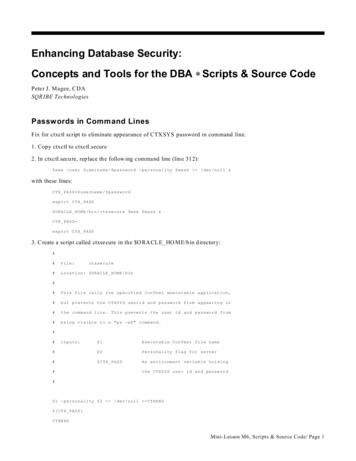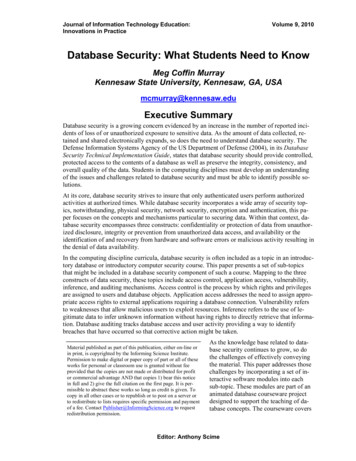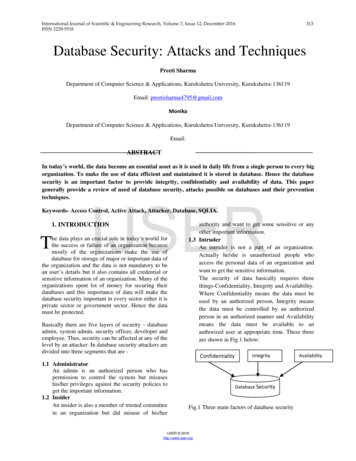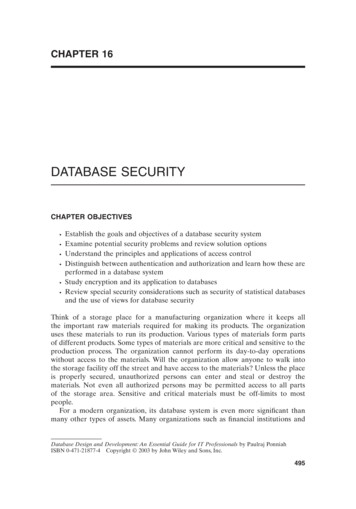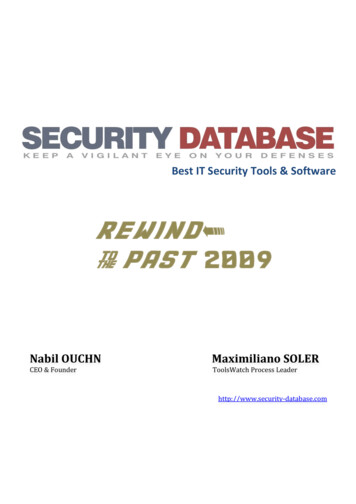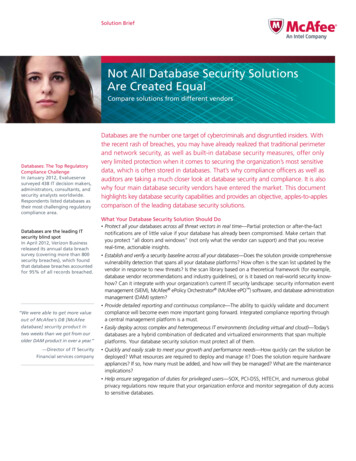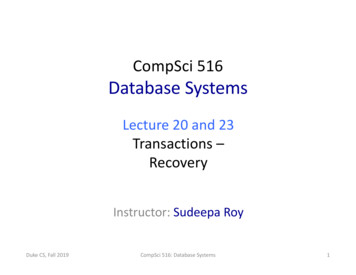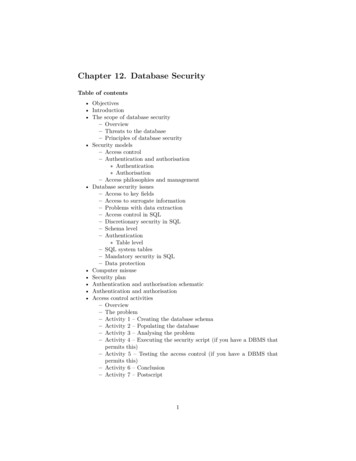
Transcription
Chapter 12. Database SecurityTable of contents Objectives Introduction The scope of database security– Overview– Threats to the database– Principles of database security Security models– Access control– Authentication and authorisation Authentication Authorisation– Access philosophies and management Database security issues– Access to key fields– Access to surrogate information– Problems with data extraction– Access control in SQL– Discretionary security in SQL– Schema level– Authentication Table level– SQL system tables– Mandatory security in SQL– Data protection Computer misuse Security plan Authentication and authorisation schematic Authentication and authorisation Access control activities– Overview– The problem– Activity 1 – Creating the database schema– Activity 2 – Populating the database– Activity 3 – Analysing the problem– Activity 4 – Executing the security script (if you have a DBMS thatpermits this)– Activity 5 – Testing the access control (if you have a DBMS thatpermits this)– Activity 6 – Conclusion– Activity 7 – Postscript1
ObjectivesAt the end of this chapter you should be able to: Understand and explain the place of database security in the context ofsecurity analysis and management. Understand, explain and apply the security concepts relevant to databasesystems. Understand, identify and find solutions to security problems in databasesystems. Understand the basic language of security mechanisms as applied todatabase systems. Analyse access control requirements and perform fairly simple implementations using SQL. Appreciate the limitations of security subsystems.IntroductionIn parallel with this chapter, you should read Chapter 19 of Thomas Connollyand Carolyn Begg, “Database Systems A Practical Approach to Design, Implementation, and Management”, (5th edn.).Security is a large subject and one that, because it touches every activity ofan information system, appears everywhere. In the main text you will startwith a thumbnail introduction to security, while the extension reading containsreferences for you to pursue when you wish.In earlier chapters in this module you have met concepts and techniques whichcan be regarded as security measures. For example, the process of recovery,whether from partial or total failure, should be considered as having a securitydimension. Nearly all the work on concurrency (see chapter 13) is directed atanother aspect of security. Again, a thumbnail introduction is given.The main work you do in this chapter, however, is directed to database securityrather than security in general, and to the principles of security theory andpractice as they relate to database security. These are technical aspects ofsecurity rather than the big picture.The chapter is organised into two parts. The first part covers security principles and models itself in two parts moving from the softer principles (settingthe universe of discourse) through to some specific technical issues of databasesecurity. The second part is about logical access control in SQL databases.The major practical area you will cover is the area of access control. After adiscussion of the principles, you will quickly be getting into some detail of access2
control in SQL databases. Extension reading, both textbooks and websites, isgiven for you to pursue the detail further.What is not covered in this chapter, but is covered elsewhere in the module, arethe subjects of database administration, transaction recovery and catastropherecovery. The first of these is directly related to management controls on operation and development. The second is directly related to database integrity andconsistency, thus being largely an internal matter. The third is easier to followas an extension of the first and second. But all three are security based.The scope of database securityOverviewAll systems have ASSETS and security is about protecting assets. The firstthing, then, is to know your assets and their value. In this chapter, concentrateon database objects (tables, views, rows), access to them, and the overall systemthat manages them. Note that not all data is sensitive, so not all requires greateffort at protection. All assets are under threat.The second thing to know is what THREATs are putting your assets at risk.These include things such as power failure and employee fraud. Note thatthreats are partly hypothetical, always changing and always imperfectly known.Security activity is directed at protecting the system from perceived threats.If a threat is potential, you must allow for it to become an actuality. Whenit becomes actual there is an IMPACT. Impact you can consider and plan for.But in the worst case, there will be a LOSS. Security activity here is directedat minimising the loss and recovering the database to minimise the loss as wellas further protecting from the same or similar threats.3
An outlined development mechanism is:1. Document assets (what they are, what their value is).2. Identify treats (what they are, how likely they are, what the impact is ifthey occur).3. Associate threats with each asset.4. Design mechanisms to protect each asset appropriate to its value and thecost of its protection, to detect a security breach against each asset, tominimise the losses incurred and to recover normal operation.Threats to the databaseYou will build your security skills from two directions. One is from the appreciation and awareness of changing threats, and the other from the technicalremedies to them. Threats include: Unauthorised modification: Changing data values for reasons of sabotage,crime or ignorance which may be enabled by inadequate security mechanisms, or sharing of passwords or password guessing, for example. Unauthorised disclosure: When information that should not have beendisclosed has been disclosed. A general issue of crucial importance, whichcan be accidental or deliberate.4
Loss of availability: Sometimes called denial of service. When the databaseis not available it incurs a loss (otherwise life is better without the system!). So any threat that gives rise to time offline, even to check whethersomething has occurred, is to be avoided.The rest of this section is an overview of the categories of specific regulatorythreats to database systems. Commercial sensitivity: Most financial losses through fraud arise fromemployees. Access controls provide both protection against criminal actsand evidence of attempts (successful or otherwise) to carry out acts detrimental to the organisation, whether fraud, extraction of sensitive data orloss of availability. Personal privacy and data protection: Internationally, personal datais normally subject to legislative controls. Personal data is data aboutan identifiable individual. Often the individual has to be alive but themethod of identification is not prescribed. So a postal code for a homemay in some cases identify an individual, if only one person is living atan address with the postal code. Such data needs careful handling andcontrol.For more information see Data Protection later in the chapter. The issuesare too extensive to be discussed here but the implications should be noted.Personal data needs to be identified as such. Controls must exist on theuse of that data (which may restrict ad-hoc queries). Audit trails of allaccess and disclosure of the information need to be retained as evidence. Computer misuse: There is also generally legislation on the misuse ofcomputers. Misuse includes the violation of access controls and attemptsto cause damage by changing the database state or introducing wormsand viruses to interfere with proper operation. These offences are oftenextraditable. So an unauthorised access in Hong Kong using computersin France to access databases in Germany which refer to databases inAmerica could lead to extradition to France or Germany or the USA. Audit requirements: These are operational constraints built around theneed to know who did what, who tried to do what, and where and wheneverything happened. They involve the detection of events (includingCONNECT and GRANT transactions), providing evidence for detection,assurance as well as either defence or prosecution. There are issues relatedto computer-generated evidence not covered here.In considerations of logical access to the database, it is easy to lose sight ofthe fact that all system access imposes risks. If there is access to operatingsystem utilities, it becomes possible to access the disk storage directly andcopy or damage the whole database or its components. A full considerationhas to take all such access into account. Most analysts would be looking tominimise communications (direct, network and telecommunications) and isolate5
the system from unnecessary threats. It is also likely that encryption would beused both on the data and the schema. Encryption is the process of convertingtext and data into a form that can only be read by the recipient of that data ortext, who has to know how to convert it back to a clear message.You will find it easier to consider security and auditing as issues separate fromthe main database functions, however they are implemented. Visualise thesecurity server and audit servers as separate functional modules.Principles of database securityTo structure thoughts on security, you need a model of security. These come invarious forms that depend on roles, degree of detail and purpose. The majorcategories are areas of interest (threats, impact and loss) as well as the actionsinvolved in dealing with them.Security risks are to be seen in terms of the loss of assets. These assets include: Hardware Software Data Data quality Credibility Availability Business benefitHere we are primarily concerned with threats to the data and data quality but,of course, a threat to one asset has consequential impact on other assets. What isalways important is that you are very clear on just what asset needs protection.So as a summary:You need to accept that security can never be perfect. There always remains anelement of risk, so arrangements must be made to deal with the worst eventuality- which means steps to minimise impact and recover effectively from loss ordamage to assets. Points to bear in mind:6
1. Appropriate security - you do not want to spend more on security thanthe asset is worth.2. You do not want security measures to interfere unnecessarily with theproper functioning of the system.Security modelsA security model establishes the external criteria for the examination of securityissues in general, and provides the context for database considerations, including implementation and operation. Specific DBMSs have their own securitymodels which are highly important in systems design and operation. Refer tothe SeaView model for an example.You will realise that security models explain the features available in the DBMSwhich need to be used to develop and operate the actual security systems. Theyembody concepts, implement policies and provide servers for such functions.Any faults in the security model will translate either into insecure operation orclumsy systems.Access controlThe purpose of access control must always be clear. Access control is expensivein terms of analysis, design and operational costs. It is applied to known situations, to known standards, to achieve known purposes. Do not apply controlswithout all the above knowledge. Control always has to be appropriate to thesituation. The main issues are introduced below.Authentication and authorisationWe are all familiar as users with the log-in requirement of most systems. Accessto IT resources generally requires a log-in process that is trusted to be secure.This topic is about access to database management systems, and is an overviewof the process from the DBA perspective. Most of what follows is directlyabout Relational client-server systems. Other system models differ to a greateror lesser extent, though the underlying principles remain true.For a simple schematic, see Authorisation and Authentication Schematic.Among the main principles for database systems are authentication and authorisation.Authentication7
The client has to establish the identity of the server and the server has to establish the identity of the client. This is done often by means of shared secrets(either a password/user-id combination, or shared biographic and/or biometric data). It can also be achieved by a system of higher authority which haspreviously established authentication. In client-server systems where data (notnecessarily the database) is distributed, the authentication may be acceptablefrom a peer system. Note that authentication may be transmissible from systemto system.The result, as far as the DBMS is concerned, is an authorisation-identifier. Authentication does not give any privileges for particular tasks. It only establishesthat the DBMS trusts that the user is who he/she claimed to be and that theuser trusts that the DBMS is also the intended system.Authentication is a prerequisite for authorisation.AuthorisationAuthorisation relates to the permissions granted to an authorised user to carryout particular transactions, and hence to change the state of the database (writeitem transactions) and/or receive data from the database (read-item transactions). The result of authorisation, which needs to be on a transactional basis,is a vector: Authorisation (item, auth-id, operation). A vector is a sequence ofdata values at a known location in the system.How this is put into effect is down to the DBMS functionality. At a logical level,the system structure needs an authorisation server, which needs to co-operatewith an auditing server. There is an issue of server-to-server security and aproblem with amplification as the authorisation is transmitted from system tosystem. Amplification here means that the security issues become larger as alarger number of DBMS servers are involved in the transaction.Audi
as an extension of the first and second. But all three are security based. The scope of database security Overview All systems have ASSETS and security is about protecting assets. The first thing, then, is to know your assets and their value. In this chapter, concentrate on database objects (tables, views, rows), access to them, and the overall systemFile Size: 238KBPage Count: 25Explore furtherDatabase Security - W3schoolswww.w3schools.inDatabase Security (DS) Pdf Notes - Free Download 2020 SWwww.smartzworld.comDatabase Auditing: Best Practiceswww.sfisaca.orgIntroduction to Security Cyberspace, Cybercrime and .www.itu.intWhat is Database Security? - Definition from Techopediawww.techopedia.comRecommended to you based on what's popular Feedback

